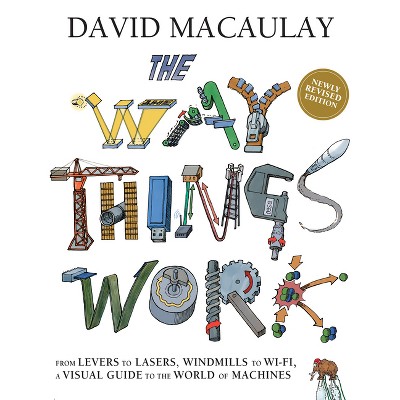Sponsored

Triumph and Erosion in the American Media and Entertainment Industries - Annotated by Dan Steinbock (Hardcover)
In Stock
Sponsored
About this item
Highlights
- How did the American media and entertainment industries decline from their global ascendancy after World War II to their present condition of instability and uncertainty?
- About the Author: DAN STEINBOCK has studied the American media and entertainment industries since arriving in New York City from his native Finland in 1986.
- 352 Pages
- Technology, Telecommunications
Description
About the Book
How did the American media and entertainment industries decline from their global ascendancy after World War II to their present condition of instability and uncertainty? How will trends in the delivery of information affect their future? These are some of the questions Steinbock asks in this comprehensive, thoroughly researched analysis. Starting with a description of shifts in the U.S. economy and ending with the coming revolution in U.S. media and entertainment--attributable to government policies, strategic alliances, and technological convergence-- Steinbock's book is no less than a Baedeker to all facets of these interlocked industries, and a provocative critique to their stengths and weaknesses in the world economy. Media and entertainment professionals will find Steinbock's views challenging and cautionary. For academics in schools of communication, the book will be a necessary source of history, data, and analysis.
In the mid-1980s, America lost its global economic leadership. The information revolution has added to uncertainty. Despite the coming electronic superhighways, the future remains clouded in the American media and entertainment industries. Steinbock's comprehensive, thoroughly researched analysis is no less than a Baedeker to all facets of these interlocked industries, and a provocative critique of their strengths and weaknesses in the world economy. The book opens with a discussion of the American economy and its macro-affects on media and entertainment, vis-a-vis the twin deficit, a stock market dominated by institutional investors, troubled banking industry, deregulation and antitrust policies, as well as the fourth national mergers and acquisition wave.
In Part I, Steinbock looks at broadcasting (tv, radio) and cable (basic and pay, pay-per-view, home shopping), exploring the former's winding fortunes and the latter's consolidation. Then, he moves to examine the Hollywood studios and talent agencies and their market multiplication: theatrical exhibition, home video and syndication, theme parks, toys, video games, licensed merchandise, record and music industry, newspapers, magazines, and books, as well as interactive multimedia, from CD-ROM to virtual reality. Each industry analysis inludes a full section devoted to all major corporate players, from networks (Capital Cities/ABC, General Electric/NBC, Loews Corp./CBS) and cable operators (TCI, Viacom, Turner) to the studios (Time Warner, Paramount, Disney, News Corp., Sony, and Matsushita). In Part II, Steinbock discusses the coming electronic superhighways and government-initiated policies that have already had a significant impact on strategic alliances (direct broadcast satellites, computers, Baby Bells, and long distance carriers). The book concludes with an assessment of how the technological, economic, and political convergence is dramatically remolding the media, entertainment, computer, and telco industries, not only in the U.S. but throughout the world.
Book Synopsis
How did the American media and entertainment industries decline from their global ascendancy after World War II to their present condition of instability and uncertainty? How will trends in the delivery of information affect their future? These are some of the questions Steinbock asks in this comprehensive, thoroughly researched analysis. Starting with a description of shifts in the U.S. economy and ending with the coming revolution in U.S. media and entertainment--attributable to government policies, strategic alliances, and technological convergence-- Steinbock's book is no less than a Baedeker to all facets of these interlocked industries, and a provocative critique to their stengths and weaknesses in the world economy. Media and entertainment professionals will find Steinbock's views challenging and cautionary. For academics in schools of communication, the book will be a necessary source of history, data, and analysis.
In the mid-1980s, America lost its global economic leadership. The information revolution has added to uncertainty. Despite the coming electronic superhighways, the future remains clouded in the American media and entertainment industries. Steinbock's comprehensive, thoroughly researched analysis is no less than a Baedeker to all facets of these interlocked industries, and a provocative critique of their strengths and weaknesses in the world economy. The book opens with a discussion of the American economy and its macro-affects on media and entertainment, vis-a-vis the twin deficit, a stock market dominated by institutional investors, troubled banking industry, deregulation and antitrust policies, as well as the fourth national mergers and acquisition wave. In Part I, Steinbock looks at broadcasting (tv, radio) and cable (basic and pay, pay-per-view, home shopping), exploring the former's winding fortunes and the latter's consolidation. Then, he moves to examine the Hollywood studios and talent agencies and their market multiplication: theatrical exhibition, home video and syndication, theme parks, toys, video games, licensed merchandise, record and music industry, newspapers, magazines, and books, as well as interactive multimedia, from CD-ROM to virtual reality. Each industry analysis inludes a full section devoted to all major corporate players, from networks (Capital Cities/ABC, General Electric/NBC, Loews Corp./CBS) and cable operators (TCI, Viacom, Turner) to the studios (Time Warner, Paramount, Disney, News Corp., Sony, and Matsushita). In Part II, Steinbock discusses the coming electronic superhighways and government-initiated policies that have already had a significant impact on strategic alliances (direct broadcast satellites, computers, Baby Bells, and long distance carriers). The book concludes with an assessment of how the technological, economic, and political convergence is dramatically remolding the media, entertainment, computer, and telco industries, not only in the U.S. but throughout the world.From the Back Cover
The book opens with a discussion of the American economy and its macro-effects on changes and developments in media and entertainment generally. Then in Part I, Steinbock looks at broadcasting and cable, tracing the former's decline and the latter's rise, and then at the "multiplication" of conglomerates: the studios, talent agencies, home video and syndication companies, theme parks, and even the emerging producers of interactive multimedia and virtual reality. A full section is devoted to all of the major players, their corporate struggles with each other, including the Time Warner and Paramount M&A wars. In Part II, Steinbock discusses the electronic superhighway and other government-initiated policies that will have a significant impact on strategic industry alliances. The book concludes with an assessment of how all of the technological, economic, and political influences emerging today will radically reshape the media/entertainment complex, not only in the United States but throughout the world.Review Quotes
.,."this is a valuable financial analysis of recent changes and trends in the entertainment industry - a topic covered in few books to date. Based on extensive work in financial records, business journals, annual reports, and the like, it presents a clear picture of the often-confusing merger and acquisition activity of recent years and its impact. Extensively illustrated with statistical tables. Steinbock has done his homework - this extensively annotated work provides an insightful review of the industry's development in the past decade, its current condition, and its future. Useful for a variety of audiences, upper-division undergraduate and above."-Choice
?...this is a valuable financial analysis of recent changes and trends in the entertainment industry - a topic covered in few books to date. Based on extensive work in financial records, business journals, annual reports, and the like, it presents a clear picture of the often-confusing merger and acquisition activity of recent years and its impact. Extensively illustrated with statistical tables. Steinbock has done his homework - this extensively annotated work provides an insightful review of the industry's development in the past decade, its current condition, and its future. Useful for a variety of audiences, upper-division undergraduate and above.?-Choice
..."this is a valuable financial analysis of recent changes and trends in the entertainment industry - a topic covered in few books to date. Based on extensive work in financial records, business journals, annual reports, and the like, it presents a clear picture of the often-confusing merger and acquisition activity of recent years and its impact. Extensively illustrated with statistical tables. Steinbock has done his homework - this extensively annotated work provides an insightful review of the industry's development in the past decade, its current condition, and its future. Useful for a variety of audiences, upper-division undergraduate and above."-Choice
About the Author
DAN STEINBOCK has studied the American media and entertainment industries since arriving in New York City from his native Finland in 1986. He holds a doctorate in communications and clinical psychology, several degrees in the social sciences and humanities, and is currently Adjunct Professor of Communication Studies at the University of Helsinki. He has also been a Fulbright visiting postdoctorate scholar, a senior researcher at Finland's prestigious Academy of Sciences, and U.S. correspondent for a variety of major newspapers and magazines in Finland. Author of a dozen previous books, this is his first major work inEnglish.

















